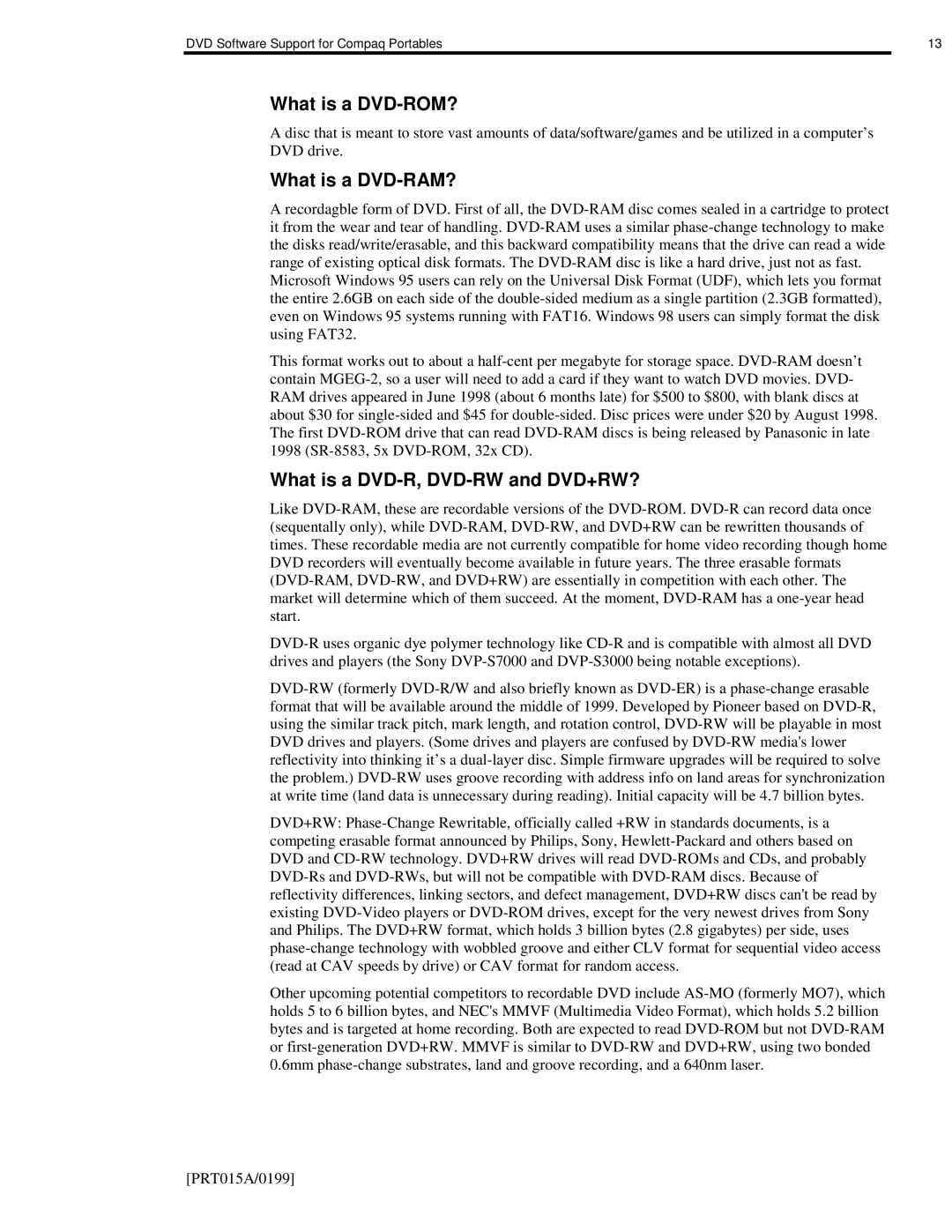What is a DVD-ROM?
A disc that is meant to store vast amounts of data/software/games and be utilized in a computer’s DVD drive.
What is a DVD-RAM?
A recordagble form of DVD. First of all, the DVD-RAM disc comes sealed in a cartridge to protect it from the wear and tear of handling. DVD-RAM uses a similar phase-change technology to make the disks read/write/erasable, and this backward compatibility means that the drive can read a wide range of existing optical disk formats. The DVD-RAM disc is like a hard drive, just not as fast.
Microsoft Windows 95 users can rely on the Universal Disk Format (UDF), which lets you format the entire 2.6GB on each side of the double-sided medium as a single partition (2.3GB formatted), even on Windows 95 systems running with FAT16. Windows 98 users can simply format the disk using FAT32.
This format works out to about a half-cent per megabyte for storage space. DVD-RAM doesn’t contain MGEG-2, so a user will need to add a card if they want to watch DVD movies. DVD- RAM drives appeared in June 1998 (about 6 months late) for $500 to $800, with blank discs at about $30 for single-sided and $45 for double-sided. Disc prices were under $20 by August 1998. The first DVD-ROM drive that can read DVD-RAM discs is being released by Panasonic in late 1998 (SR-8583, 5x DVD-ROM, 32x CD).
What is a DVD-R, DVD-RW and DVD+RW?
Like DVD-RAM, these are recordable versions of the DVD-ROM. DVD-R can record data once (sequentally only), while DVD-RAM, DVD-RW, and DVD+RW can be rewritten thousands of times. These recordable media are not currently compatible for home video recording though home DVD recorders will eventually become available in future years. The three erasable formats (DVD-RAM, DVD-RW, and DVD+RW) are essentially in competition with each other. The market will determine which of them succeed. At the moment, DVD-RAM has a one-year head start.
DVD-R uses organic dye polymer technology like CD-R and is compatible with almost all DVD drives and players (the Sony DVP-S7000 and DVP-S3000 being notable exceptions).
DVD-RW (formerly DVD-R/W and also briefly known as DVD-ER) is a phase-change erasable format that will be available around the middle of 1999. Developed by Pioneer based on DVD-R, using the similar track pitch, mark length, and rotation control, DVD-RW will be playable in most DVD drives and players. (Some drives and players are confused by DVD-RW media's lower reflectivity into thinking it’s a dual-layer disc. Simple firmware upgrades will be required to solve the problem.) DVD-RW uses groove recording with address info on land areas for synchronization at write time (land data is unnecessary during reading). Initial capacity will be 4.7 billion bytes.
DVD+RW: Phase-Change Rewritable, officially called +RW in standards documents, is a competing erasable format announced by Philips, Sony, Hewlett-Packard and others based on DVD and CD-RW technology. DVD+RW drives will read DVD-ROMs and CDs, and probably DVD-Rs and DVD-RWs, but will not be compatible with DVD-RAM discs. Because of reflectivity differences, linking sectors, and defect management, DVD+RW discs can't be read by existing DVD-Video players or DVD-ROM drives, except for the very newest drives from Sony and Philips. The DVD+RW format, which holds 3 billion bytes (2.8 gigabytes) per side, uses phase-change technology with wobbled groove and either CLV format for sequential video access (read at CAV speeds by drive) or CAV format for random access.
Other upcoming potential competitors to recordable DVD include AS-MO (formerly MO7), which holds 5 to 6 billion bytes, and NEC's MMVF (Multimedia Video Format), which holds 5.2 billion bytes and is targeted at home recording. Both are expected to read DVD-ROM but not DVD-RAM or first-generation DVD+RW. MMVF is similar to DVD-RW and DVD+RW, using two bonded 0.6mm phase-change substrates, land and groove recording, and a 640nm laser.
